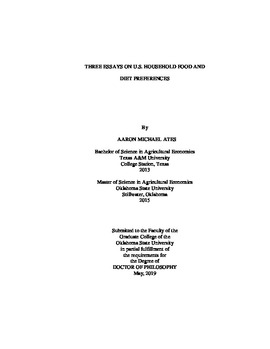| dc.contributor.advisor | Holcomb, Rodney Brian | |
| dc.contributor.author | Ates, Aaron Michael | |
| dc.date.accessioned | 2019-10-25T19:02:55Z | |
| dc.date.available | 2019-10-25T19:02:55Z | |
| dc.date.issued | 2019-05-01 | |
| dc.identifier.uri | https://hdl.handle.net/11244/321526 | |
| dc.description.abstract | This dissertation focuses on U.S. household food and diet preferences. The first study seeks to determine the effect of rising interest in gluten-free food(s) on retail demand for U.S. foods and ultimately on producer and consumer welfare. Increased interest in gluten-free diets causes a significant decrease in cereals and bakery demand and increases meat, alcoholic beverages, and food away from home demand. Combining estimated demand effects with an equilibrium displacement model suggests the estimated reduction in cereal and bakery demand reduces wheat and barley producer profits by $7.2 million/year. However, after accounting for positive demand impacts on other products, results indicate wheat and barley supply is re-distributed away from food production into animal production, increasing wheat producer welfare. Rising interest in gluten-free is estimated to have increased meat producer welfare by $3.7 billion/year. | |
| dc.description.abstract | The purpose of the second study is to provide insight as to what portion of the food resource gap is covered by food assistance programs like SNAP - monetarily and nutritionally. Holding household size constant, least squares means is used to compute and compare mean food expenditures and caloric/macronutrient requirements with Tukey-adjusted difference of means F-tests across household SNAP eligibility/participation statuses. The amount of calories required by each household type is not statistically different. Although SNAP households require fewer calories than non-participating households, they purchase significantly more calories from all foods each week - totaling 45,311 calories. This is 5,478 more calories than required for a healthy diet. | |
| dc.description.abstract | The third study seeks to determine whether a new SNAP policy will successfully support endeavors to provide low-income people access to a healthful diet. Changes in weekly caloric consumption by SNAP households are estimated for various products when imposing a 30% reduction in prices for targeted foods. Results suggest discounting the price(s) of targeted foods will indeed increase the demand of these goods; however, total calories consumed by SNAP households will increase by 118 - 2,661 calories each week (depending on which food is targeted). Because SNAP households currently purchase more calories than are required for a healthy diet, this new policy may not have the desired overall effect. | |
| dc.format | application/pdf | |
| dc.language | en_US | |
| dc.rights | Copyright is held by the author who has granted the Oklahoma State University Library the non-exclusive right to share this material in its institutional repository. Contact Digital Library Services at lib-dls@okstate.edu or 405-744-9161 for the permission policy on the use, reproduction or distribution of this material. | |
| dc.title | Three Essays on U.S. Household Food and Diet Preferences | |
| dc.contributor.committeeMember | Lusk, Jayson | |
| dc.contributor.committeeMember | Norwood, F. Bailey | |
| dc.contributor.committeeMember | Zhu, Lan | |
| osu.filename | Ates_okstate_0664D_16158.pdf | |
| osu.accesstype | Open Access | |
| dc.type.genre | Dissertation | |
| dc.type.material | Text | |
| thesis.degree.discipline | Agricultural Economics | |
| thesis.degree.grantor | Oklahoma State University | |
